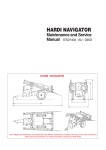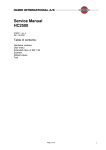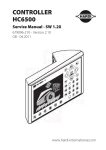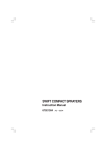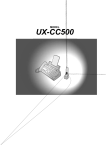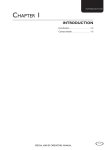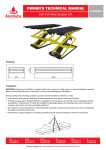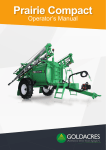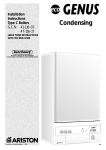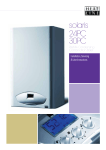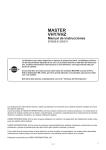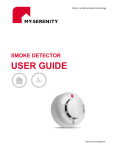Download Navigator Operators Manual.pmd
Transcript
HARDI NAVIGATOR Operator’s Manual 67021104 - AU - 03/03 HARDI NAVIGATOR 5000L HARDI NAVIGATOR 28m SPB Boom 1707 Kg 7435 Kg Note: Weights and dimensions vary significantly with different combinations of chassis, tank size, axles, suspension, boom, Note: Dimensions are a guide only - weights and measures will vary with different axle, suspension, wheel equipment and boom combinations. wheel size and accessories. For further details, please contact your Hardi dealer. HARDI NAVIGATOR HARDI NAVIGATOR Operator’s Manual Part number 67021104 MARCH 2003 Edition Published by HARDI AUSTRALIA Pty Ltd Adelaide, South Australia HARDI AUSTRALIA Pty Ltd assumes no responsibility for any errors, inaccuracies or possible omissions in this publication. Illustrations, technical information and data are to the best knowledge of Hardi Australia Pty Ltd, correct at the time of printing. HARDI AUSTRALIA Pty Ltd reserves the right to make changes in design, features, accessories, specifications and instructions at any time and without notice. Hardi Australia Pty Ltd is without any obligation in relation to products purchased before or after such changes. Copyright © 2003 HARDI AUSTRALIA Pty Ltd All rights reserved All operators of the equipment dealt with by this publication must read this entire publication prior to operating any of the equipment. The safety section must be thoroughly read and understood. Writing and layout by HARDI AUSTRALIA Pty Ltd Failure to do so may result in injury or death. Printed in Australia www.hardi.com.au After changing chemicals or crops it is essential that the entire spraying system be flushed and thoroughly decontaminated in accordance with the chemical manufacturer’s instructions (refer to the chemical label). This includes disconnecting hoses from the self cleaning filter and pressure relief valve and cleaning any residue and sediment found in the hoses, valve and filter. Failure to do so may lead to potential crop damage. 2 HARDI NAVIGATOR Contents OPERATORS MANUAL Introduction................................................................................4 Sprayer use..........................................................................4 Sprayer Layout.....................................................................4 Identification plates..............................................................4 Important Safety Guidelines......................................................4 Description.................................................................................5 Frame...................................................................................5 Suspension..........................................................................5 Adjustable Width Axles....................................................5 Tank......................................................................................5 Pumps..................................................................................5 HARDI SMART VALVE system............................................5 EVC operating unit...............................................................5 HARDI HC 2500 Controller .................................................5 HARDI HC 5500 Controller..................................................5 Filters....................................................................................5 Booms.................................................................................5 HARDI Foam Markers..........................................................5 Flush tank.............................................................................5 Flush nozzle.........................................................................5 Hand wash tank...................................................................5 Filtered fill system.................................................................5 GRANNI POT chemical induction........................................5 Sprayer Setup........................................................................6 Connection...........................................................................6 Support leg...........................................................................6 Fold-down Access Step.......................................................6 Transmission shaft installation.............................................6 Wheel track..........................................................................7 Tyres.....................................................................................8 Connecting hydraulics.........................................................8 Connecting electric controls...........................................8 Emergency operation - Power Failure............................. 8 EVC 3 / EVC 4 Operating Unit..............................................9 Control boxes and Power Supply....................................9 Controls Setup.................................................................9 Pressure Equalisation Setup...........................................9 Subsequent Adjustments................................................9 EVC Operation while spraying........................................9 EVC Operating Unit Valve Cone......................................9 Remote Pressure Gauge...................................................10 Filters.................................................................................10 Self cleaning filter...............................................................10 HARDI Foam Markers........................................................11 Operation.......................................................................11 Remote control box........................................................11 System drain and flush..................................................11 Flush Tank and Flush Nozzles............................................11 Boom..............................................................................11 Emergency operation - Power Failure...........................11 Before operating sprayer.........................................................12 Roadworthiness.................................................................12 Disconnecting sprayer.......................................................12 Powerline Warning.............................................................12 Function diagrams...................................................................13 OPERATION..............................................................................14 HARDI SMART VALVE system..........................................14 Filling Tanks with Water...................................................14 Tank Capacities.............................................................14 Filling through tank lids..................................................14 Filling with HARDI SMART VALVES...............................15 Filling Foam Tank..................................................16 Filling Foam and Flush Tanks at the same time.................16 Filling Flush Tank................................................................16 Filling Foam and Main Tanks at the same time..................16 Filling Main Tank.................................................................16 Adding chemicals...............................................................17 Safety precautions............................................................17 Adding chemicals through the tank lid................................18 Adding chemicals with GRANNI POT............................18 A) Adding chemicals to part-filled Main Tank (recommended)...................18 B) Adding chemicals after filling Tanks...............................19 C) Adding chemicals while filling Main Tank.......................19 Spraying Operation.............................................................20 Spray with Agitation............................................................20 Spray without Agitation......................................................20 Interrupted spraying and Standby Mode............................20 After spraying is completed.....................................................21 Disposal of unused and residual spray solution..........21 Technical residue dilution...................................................21 Dilution and Disposal.........................................................21 Draining Tanks.................................................................21 Main, Flush and Foam Marker tank drainage....................21 Cleaning and Decontamination...............................................22 General Cleaning Guidelines.............................................22 Cleaning Procedure.........................................................23 Decontamination.............................................................24 Final Rinse........................................................................24 Storage......................................................................................25 Preparation before off-season storage..............................25 Preparation after off-season storage.................................25 MAINTENANCE AND SERVICE MANUAL Sprayer Setup and Adjustments........................................4-8 Maintenance Outline..................................................................9 Cleaning and Decontamination.............................................9 Lubrication.............................................................................10 Pumps...........................................................................10 Support leg....................................................................10 Transmission shaft........................................................10 Wheel bearings.............................................................10 Hitch..............................................................................10 Service and maintenance charts.......................................11 Occasional maintenance...................................................13 Pumps, EVC,Transmission shaft, Shock Absorbers, Level Indicator, Drain Valve Seal, Hoses and Fittings, Tyres..............................................................13-17 Storage......................................................................................18 Troubleshooting.......................................................................19 Specifications...........................................................................22 Torque settings......................................................................22 Tyre pressures.......................................................................22 Temperature and Pressure....................................................22 Flow.......................................................................................22 Dimensions............................................................................22 Pump Capacity.......................................................................22 Filters.....................................................................................22 Materials and Recycling........................................................22 Replacement Parts............................................................24-51 HARDI CONTACTS...................................................................54 EMERGENCY CONTACTS.......................................................54 3 HARDI NAVIGATOR Introduction Congratulations on purchasing a HARDI NAVIGATOR sprayer. The reliability and efficiency of this sprayer depends upon your care. The first step is to take the time to carefully read this operators manual. It contains essential information on efficient and safe operation of the HARDI NAVIGATOR sprayer. Sprayer options are also covered in this manual. This manual covers HARDI NAVIGATOR with PARALIFT-mounted FALCON or EAGLE boom . An Operator’s Manual for your boom is supplied with your NAVIGATOR sprayer documentation. Thank you for choosing HARDI and welcome to the increasing family of HARDI spraying equipment owners. Sprayer use The HARDI NAVIGATOR sprayer is for the application of plant protection and fertiliser chemicals. The sprayer must only be used for these purposes. It is not allowable to use the sprayer for other purposes. If no local law demands that the operator must be certified to use spray equipment, it is strongly recommended operators be trained in the safe handling of plant protection chemicals and plant protection, to avoid unnecessary risk for persons, crops and the environment. Sprayer Layout Identification plates An identification plate is fitted on the frame and indicates: Producer Name, Model, Serial Number, Date and Dealer Name / Code. The boom frame also has identification plates. Please record applicable details below: Producer Name: ..................................................... Model:..................................................................... Serial Number: ....................................................... Date: ....................................................................... Dealer Name / Code: .............................................. 4 Important Safety Guidelines This is the safety alert symbol: When you see the symbol in this manual or on any spraying equipment, be alert! It means WARNING! your safety is involved. Note the following recommended precautions and safe operating practices: Read and understand this operators manual before using the equipment. Also ensure all other operators of this equipment read and understand this manual. Always read chemical labels prior to use and follow the instructions they contain. Chemical labels are registered by the National Registration Authority. However each state governs the purpose for which a chemical may be used and this may vary from state to state. Local law may demand that the operator be certified to use spraying equipment. Adhere to the law. Pressure test with clean water prior to using chemicals. Wear protective clothing. Rinse and wash equipment after use and before servicing. Depressurise equipment after use and before servicing. Never service or repair the equipment whilst it is operating. Disconnect electrical power before servicing. Always replace all safety devices or shields immediately after servicing. Disconnect power leads and electronic equipment before welding any part of the sprayer, boom or attached equipment. Remove all inflammable or explosive material from the area. Do not eat, drink or smoke whilst spraying or working with contaminated equipment. Wash and change clothes after spraying. Wash tools if they have become contaminated. In case of poisoning, immediately seek medical advice. Remember to identify chemicals used. Read First Aid instructions on Chemical Labels. Keep children, animals and unauthorised people away from the equipment . Never attempt to enter the sprayer tank. Do not go under any part of the equipment unless it is securely supported. The boom is secure when placed in the transport brackets. Do not use the sprayer step unless the sprayer is connected to the tractor or the sprayer is correctly placed on a hard, flat surface. If any portion of this operator’s manual remains unclear after reading it, contact your HARDI dealer for further explanation before using the equipment. Do not affix or weld any additional item to the sprayer, as this may affect the structural integrity of your sprayer. HARDI NAVIGATOR HARDI HC 5500 Controller (If fitted) Description Frame The frame is an all steel construction. It has a strong chemical and weather resistant powder coated finish. Suspension When fitted, features trailing arms, coil springs and oil shock absorbers. Adjustable Width Axles When fitted, allows width adjustment between 1.5 and 3.0 metres, subject to suspension and wheel equipment. Tank UV-resistant Polyethylene tank, designed with limited sharp corners for easy agitation, emptying and cleaning. Nominal contents are 3000, 4000 or 5000 litres. (Tank contents can differ from nominal due to production variances. Pump A 363/540 rpm Hardi diaphragm pump is fitted (or, depending on boom width, optional 363/1000 rpm or 463/540 or 1000). All diaphragm pumps feature a dry sump and grease lubrication, and have easily accessible valves and diaphragms. Optional Ace centrifugal pumps are also available. Ace Pumps have factory lubricated bearings and require no further lubrication. HARDI SMART VALVE system Functions of the sprayer circuit are selected via the centrally located HARDI SMART VALVES, featuring colour coding and clear symbols for easy operation. Flush tank A 500L tank is fitted for the purpose of flushing the boom, controls, filters and to pre-flush the main tank, depending on the chosen position of the SMART VALVE handles. The tank is hinged to allow easy access to the SMART VALVES for maintenance, and the moulded steps and platform feature a slip resistant washable surface on the treads. Flush nozzle The flush nozzles fitted inside the main tank, operated with the SMART VALVE system, are used to flush the tank during cleaning and decontamination procedures. Hand wash tank A separate15L tank is fitted to provide clean water for hand washing or rinsing (not to be used for drinking water). Filtered fill system The filtered fill system allows filling of the main, foam and flush tanks from a fire fighter or overhead fill tank. HARDI HC 2500 Controller (If fitted) The HARDI HC 2500 is an easy to use controller, featuring preset keys and a 2-line display. The control panel and LCD display screen mount in the tractor cab via the single cable. Please refer to the HARDI HC 2500 Controller Manual. The HARDI HC 5500 is an easy to use controller, featuring preset keys and a large 4-line display. The control panel and LCD display screen mount in the tractor cab via the single cable. Please refer to the HARDI HC 5500 Controller Manual. EVC operating unit The EVC operating unit is a modular assembly, consisting of a pressure regulation with remote-mounted gauge, and distribution valves with pressure equalisation.This ensures a constant volume per hectare of the liquid (l/ ha) at varying forward speed within the same gear when the PTO revolutions are between 300 - 600 rpm. The operating unit is fully electrically controlled via the HARDI 2500 or 5500 Controller. Filters Integrated Hardi filters ensure optimal filtration of spray liquids, preventing system blockages and promoting consistent and accurate application of chemicals. The water supply is first filtered as it passes through the Fast Fill Filter into the tanks. The top mounted suction filter and the self-cleaning filter prevent impurities entering the spray circuit, while further filtration can be achieved by optional In-line filters, before the spray solution reaches the nozzles. Fine mesh filters within the nozzles finally prevent small particles blocking the nozzle openings. Booms Booms feature trapeze suspension and an integrated spring suspension system with shock absorber dampening. Boom heights are adjusted with a PARALIFT (parallelogram boom lift). The HARDI NAVIGATOR boom options are as follows: 1 FALCON PARALIFT 12.5-16.5m Hydraulic Lift, Hydraulic Fold & Optional Hydraulic Tilt. 2 EAGLE PARALIFT 18-30M Hydraulic Lift, Hydraulic Fold & Optional Hydraulic Tilt. Refer to the Boom Operators Manual supplied. HARDI foam markers The high capacity double-sided foam marker system fitted is 12 volt operated. It uses a small fluid pump to drive the foam mixture from the140L tank. Compressed air is then used to generate foam at the foam generators. This aerated foam is then forced to the selected boom end, to be dropped via the dropper. GRANNI POT Chemical Induction System A 60 litre mixing and transfer hopper, safely transfers all chemical liquids, powders and granules to the sprayer tank.The GRANNI POT drum rinse nozzle can be used to flush empty containers. When fitted with a Vacuum Transfer assembly, a suction probe sucks liquid from a container into the Granni Pot, where it is mixed and then transferred to the Main Tank. 5 HARDI NAVIGATOR Fold-down Access Step Sprayer Setup Connection To access the front platform the step lockpin is pulled out and the step folded down. Always lift up and push the step in against the Flush Tank before driving. The step will lock automatically when it is pushed fully in. WARNING! Always ensure the FlushTank tiedown strap is secured before moving sprayer or climbing onto steps. WARNING! Ensure the moulded steps on the Flush Tank are kept clear of mud and debris to optimise their slip-resistant properties. B A 90o Fig 1 To connect the sprayer to the tractor, adjust the tow ring hitch mounting height (A Fig 1) on the drawbar so that the trailer frame is level. WARNING! Drawbar bolts must be re-tightened every 8 hours of work until torque is stabilised to the values specified in Maintenance and Service Manual, then retightened as part of a regular maintenance schedule. WARNING! Ensure the drawbar is secured to the tractor and cannot be accidentally disconnected use bushes to reduce slack. Safety chain mounting point is provided. WARNING! Your tractor will have decreased braking efficiency with the sprayer connected, particularly when the tank is full. Support leg To remove support leg (B Fig 1): While sprayer is attached to the tractor, lift leg, remove securing pin and pull out support leg. Support leg can be stored on the jack mount by turning to horizontal position and securing with the pin (see below). Fig 3 Transmission shaft installation Initial installation of the transmission shaft may require shortening of the shaft. 1 Attach the sprayer to the tractor and set the sprayer at a height allowing the shortest length of the transmission shaft with the tractor set at a turning angle. 2 Stop the engine and remove the ignition key. 3 If the transmission shaft must be shortened, pull the shaft apart. Fit the separated shaft parts to the tractor and sprayer pump and measure how much it is necessary to shorten the shaft. Mark the protection guards. Fig 4 NOTE! The shaft must always have a minimum overlap of 1/3 of the length. Fig 2 WARNING! The support leg is not designed for jacking up a full sprayer, or supporting the trailer for extended periods if the sprayer is full of water. 1 Fig 5 6 /3 1 /3 1 /3 HARDI NAVIGATOR MIN 20 mm WARNING! It is not permitted to fit dual wheels. CAUTION! Stability of the sprayer at high speed can be reduced with narrow wheel tracks. Fig 6 4 Shorten the two separated parts equally. Use a saw and file the profiles afterwards to remove burrs. 5 Grease profiles. Re-assemble male and female parts. 6 Grease the tractor and sprayer pump PTO shafts. 7 Fit the transmission shaft to the tractor and sprayer pump PTO shafts: Push the yoke pin and slide the yoke onto the PTO shaft. Make sure that the lock engages by pushing and pulling forwards and backwards. Fit the chains to prevent protection guards from rotating with the shaft. Wheel track is altered the following way: NOTE! Please fit the female part marked with a tractor symbol towards the tractor. Fig 7 NOTE! To ensure long life of the transmission shaft try to avoid working angles greater than 25°. Fig 10 1 Measure the correct wheel track (Centre of right hand tyre to centre of left hand tyre). Extend or retract each side equally to achieve the desired alteration. 2 Attach sprayer to the tractor and engage tractor parking brake. 3 Place stop wedges in front of and behind the right hand wheel. Using suitable heavy duty equipment, jack up the left hand wheel. Ensure secure support for the sprayer body. 25° Fig 8 Wheel track Where an adjustable axle is fitted, the wheel track can be altered infinitely from 1500 mm to 3000 mm by extending or retracting the wheel axle, depending on wheel and suspension options. 1500 mm to 3000 mm Fig 9 Fig 11 4 To release axle wedge for the left hand wheel axle and extend or retract the axle: Turn Nut C (Fig 11) anti-clockwise to allow approx. 30 mm clearance.With an open-ended spanner turn Nut D (Fig 11) against anchor plate until hold on axle is released. Shift axle to measured position. 5 To tighten axle wedge and secure axle at required width: Turn Nut D anti-clockwise to allow movement of stop wedge.Turn Nut C clockwise against anchor plate to draw stop wedge up against the axle and hold it in position. Tighten to torque of 280 Nm, then lock by re-tightening Nut D. 7 HARDI NAVIGATOR 6 If the wheels are reversed and exchanged, remember to tighten the wheel nuts to the specified torque rim plate to hub = 270 Nm / M18 or 337 Nm / M20. 7 Repeat the procedure on the right hand wheel. 8 Check the distance from the centre of the tyre to the centre of the tank, to make sure the distance is equal from left to right. 9 Re-tighten the axle wedges and wheel nuts to the specified torque after 4, 8, 16, and 24 hours of work. IMPORTANT! Always place a jack under axle and lift the wheel to remove the load from the clamps before tightening the clamp bolts. (Caution: Do not attempt to jack up sprayer with full tank). HC2500 Remote control box Tyres Equal pressure in both tyres is essential. Pressure should be kept as low as practical, i.e. baggy when the tank is full. Check the tyre pressures against the table below, and Load Limit table on P26. TYRE 12.4 x 46 18.4 x 38 18.4 x 30 23.1 x 30 MAX PRESSURE (kPa) Road Work 240 145-155 240 145-155 200 145 200 145 Fig 12 HC2500 Display and Control Box NOTE! Sprayers fitted with controllers must always maintain the same tyre pressure as when calibrated. WARNING! Never inflate tyres above the manufacturer’s specified pressures. Over inflated tyres can explode and cause severe personal injuries. Connecting hydraulics Please refer to the Boom Operator’s Manual supplied with your sprayer documentation regarding connecting hydraulics, boom operation, adjustment and maintenance. Connecting electric controls Fig 13 HC5500 Display and Control Box Control boxes must be fitted in the tractor cabin at a convenient place. 12 volt power sockets are required. The wires must have a cross-sectional area of at least 4.0 mm2 to ensure sufficient power supply. The boxes must be fused according to the following table. Control Box EVC operating unit Foam marker Distribution valves Polarity / Wire colour (+) (-) Brown Blue White Black Brown Blue Fuse (Amp) 10 20 10 NOTE! Refer to the Boom Operator’s Manual supplied with sprayer documentation re connecting boom electric controls. For installation, operation and maintenance details for Controllers, see the relevant Controller Operators Manual. Emergency Operation Refer to the troubleshooting sections of the Maintenance Manual, Boom Operators Manual and Controller Manual. In case of power failure check fuses (Use 1.25T Amp fuse). It is possible to operate all functions of the operating unit manually. First disconnect the Controller (See Controller Operators Manual for directions), then manually turn the emergency control knobs on the EVC units as required. 8 Fig 14 HARDI NAVIGATOR EVC 3 / EVC 4 Operating Units Setup Operating unit The EVC has distribution valves with a constant pressure equalisation system, allowing sectional control of the sprayer without changing pressure. It gives a constant application rate within the same gear when the number of PTO revolutions are between 300 - 600 rpm (540 pump), or 650-1100 (1000 pump). A pressure gauge is also fitted. The operating unit is fully electrically controlled via a remote control box or the HARDI Controller. Control boxes and power supply Power requirement is 12V DC. Note Polarity! Brown Wire is pos. (+), Blue neg. (-). A Controls Setup Procedure Fig 15 Before spraying, the EVC operating unit is adjusted using clean water (ie without chemicals). 1 Choose the correct nozzle for the spray job. Make sure that all nozzles are the same type and capacity. Please see your dealer or the Hardi Spray Technique book for Nozzle selection guidance. 2 Switch on the EVC using the Controller / Control Box. 3 Activate all distribution valves to the open position. 4 Decrease the pressure until the pressure control valve handle (A Fig 15) stops rotating (minimum pressure). 5 Put the tractor in neutral and adjust the PTO revolutions to the intended travelling speed. Remember the number of revolutions of the PTO must be kept between 300-600 rpm (540 pump), or 650-1100 (1000 pump). 6 Increase the pressure until the required pressure is shown on the pressure gauge. Pressure Equalisation unit Pressure equalisation Setup Procedure 1 Close the first section of the distribution valves. 2 Turn the first section adjusting screw (A Fig 16) until the pressure gauge shows the same pressure again. 3 Adjust the other sections of the distribution valve in the same way. Subsequent Adjustments NOTE! Hereafter adjustment of pressure equalisation will only be needed when you change to nozzles with other capacities or the nozzle output increases as the nozzles wear. EVC 3 / EVC 4 Operating Unit Valve Cone Periodically check the distribution valves for proper sealing. Do this by running the sprayer with clean water and opening all distribution valves. For maintenance of the EVC Operating Unit, see your Maintenance and Service Manual. A Fig 16 EVC Operation while spraying When the entire boom is closed, the pump output then returns to the tank. The non-drip diaphragm valves allow simultaneous closing of all the nozzles. Vary operating pressure until the required pressure is shown on the pressure gauge. To close one or more sections of the boom, close the relevant distribution valve switch. The pressure equalisation ensures that the pressure does not rise in the sections which are to remain open. Note! If there are problems with the HC 2500 or HC 5500 (and you need to operate the EVC manually): Please refer to the relevant Operators Manual for advice on how to disconnect the controller. NOTE! When the sprayer is not in use, the control box and the multi plug must be protected against moisture and dirt. A plastic bag may be used to protect the multi plug. NOTE! Outputs stated in the nozzle charts are always based on the pressure measured at boom. 9 HARDI NAVIGATOR Remote pressure gauge The remote pressure gauge measures the working pressure near the pressure regulator, and is an indicator of pressure changes within the system. Note: This pressure reading will vary slightly from the reading at the distribution manifold pressure gauge. The outputs stated in the nozzle charts are always based on the pressure measured at the nozzle. When calibrating and spraying, adjust pressure according to readings at the pressure gauge located closest to the boom. As standard, units with 363 pumps will be fitted with Black and 463 pumps with Green restrictors. A A= From Smart Valves C B= Double Filter Screen C= Guide Cone B D= To Boom Section Valves E= Replaceable Restrictor F= Return to Tank D E F 334200 RED 334202 BLACK 334201 WHITE 334203 GREEN Fig 17 Filters Filters should always be used, and their function checked regularly. The mesh size of the filter should always be smaller than the flow average of the nozzles used. Therefore, pay attention to the correct combination of filters and mesh size. The recommended suction filter is 50 mesh - this allows good flow to the pump with little restriction. The standard self cleaning filter is 100 mesh. Refer to the chart below for correct filter recommendations. Flat Spray Nozzle Size 0075 - 02 025 - 03 04 and more Suction Filter 80 50 30 Self Cleaning Filter 100 80 80 (50) In-Line Filter 100 80 50 Fig 18 Cleaning When cleaning the filter, remove all hoses and check there is no residue. Standard filter size is 100 mesh. Sizes of 50 and 80 mesh are available and can be changed by opening the filter top (replace the strainer). Check the O-rings before reassembling the filter and replace them if damaged. Also refer to 10-HOURLY MAINTENANCE - Self Cleaning Filter, (Maintenance Manual). Nozzle Filter 100 80 (50) 50 Suction filter screens do wear from dirt and chemical particles. If nozzle filters continually block with chemical particles, then use the next size coarse nozzle filter. Self cleaning filter IMPORTANT! Note direction of restrictor in Fig 19. Correct restrictor choice It is important to have a large flow through the filter. This is achieved by choosing restrictor size in relation to the liquid consumption of the spray boom and pump output. Disconnect the hose (Fig 19) at the self cleaning filter, place the restrictor in the hose and reconnect. If the required working pressure cannot be obtained, the restrictor may be too large. There are four sizes, green is the largest, then black, white and finally red. 10 Fig 19 HARDI NAVIGATOR HARDI Foam Markers (General Notes) Foam Marker System drain and flush Ensure the system is clean. Add clean water to the tank first, then foam concentrate according to concentrate instructions. Recommended rate for Hardi Foam concentrate 1:25 (ie. in 100L add 4L Concentrate). For good quality foam note the following: • Mix contents after adding foam • Use clean water, preferably rain water • Do not use dam water or bore (hard) water • Do not use water containing salt or minerals • Flush the system to prevent it gumming up • Drain residue if more than a week old • Use water with a temperature above 13° C • Store concentrate in a frost free area Cold operating conditions decrease foam quality, leading to blowouts where the foam spurts out of the generator. 1 Undo 1” Nut and disconnect fill hose below Foam Tank. 2 Allow tank and hose to drain. Flush tank with clean water. 3 Check the filter is clean. 4 Reconnect hose. 5 Add 7 litres of clean (preferably hot) water. 6 Start the pump and pump liquid through the system. 7 Repeat points 5 and 6 if necessary. CAUTION! Do not clean the Foam Marker compressor box with a high pressure cleaner. Foam Marker Operation (See your Foam Marker Operators Manual for more details) 1 Add water (see Filling of water (Page 14), then foam concentrate, to the foam marker tank. Close the lid. 2 Connect the power supply. 3 Note: Some Hardi Foam Marker units work as stand alone, ie. controlled with Foam Marker control box (Fig 20). Remote control box (Cyclone) Flush tank and flush nozzle Clean water contents of the incorporated 500L litre flush tank can be used for diluting and flushing. Flushing the system without diluting Main Tank contents can be required when spraying is interrupted or during Stand-by (See Page 20). To dispose of unused chemical solution, it will be necessary to dilute any remaining spray liquid residue in the spraying circuit at the end of your spraying task. The dilute liquid is sprayed at a very low application rate into the same field you have just sprayed. This is done before cleaning the sprayer and/or using different chemicals. (See Page 21 for detailed procedure). At the completion of spraying the entire sprayer must be cleaned, decontaminated and rinsed (Page 22). The tank flush nozzles cannot always guarantee a 100% cleaning of the tank. Always clean manually with a brush afterwards, especially if crops sensitive to the chemical you have just used are going to be sprayed next. Boom Fig 20 Turn unit on by moving switch to Left/Right position. This starts the air compression, starts 12V pump to charge liquid to lines and operates the valves to direct compressed air to selected side. Liquid is mixed with compressed air to produce foam. Note: Where HC 5500 is fitted, the foam marker is controlled with the centre R Hand switch. Refer to Operators Manual to perform the required functions. 4 Blob frequency can be adjusted as required. The foam marker system must be kept clean to ensure foam is of good quality. Drain and flush when: • Quality of foam produced is poor • Preparing for off-season storage • Residue is more than a week old • Impurities are seen in the tanks Please refer to the supplied EAGLE or FALCON PARALIFT BOOM Operator’s Manual regarding entire operation of the boom. WARNING! Operate the boom only after reading the operator’s manual. DANGER! When folding and unfolding the boom, be sure that no person or objects are in the operating area of the boom. DANGER! When folding and unfolding the boom, transporting sprayer or working above the unit, always observe minimum safe clearance from powerlines. (See Page 12). Emergency operation In case of power failure, boom distribution can be controlled manually by turning the taps on the EVC motors. Refer to the Troubleshooting section in the Boom Operators Manual supplied with your sprayer for solutions to boom fold / unfold problems. 11 HARDI NAVIGATOR BEFORE OPERATING SPRAYER Although the sprayer has had a strong and protective surface treatment applied to steel parts, bolts, etc. in the factories, it is recommended to apply a thin layer of anti-corrosion oil to all metal parts, hoses and tyres. Suggested products for protecting your equipment are HENKEL, SHELL ENSIS or one of the CASTROL RUSTILLO range, eg DW9011M1. There are many factors that affect the selection of protective oils, such as temperature and humidity, and exposure to UV, salt and chemicals. Your local distributor of oil products will be able to advise on the best specific formula for your local conditions. If this is done before the sprayer is put into operation for the first time, it will always be easy to clean the sprayer, avoid chemicals discolouring the protective coating, and keep the coatings shiny for many years. This treatment should be carried out every time the protective film is washed off. WARNING! If the sprayer is parked unattended, avoid unauthorised persons, children and animals having access to the sprayer. 12 Roadworthiness When driving on public roads and any other areas where traffic laws apply, please ensure that the required signs and lights are fitted and working. WARNING! Maximum driving speed is the lesser of: 20 km/h less than the posted speed limit; and 40 km/h; and the tyre manufacturers recommended maximum speed / load. NOTE! It is always recommended to only move the sprayer by road with an empty tank. NOTE! Ensure towing vehicle is suited to total load. Disconnecting sprayer Disconnect and park the sprayer for storage only after thorough cleaning and decontamination. (Cleaning P22). Leave the sprayer connected to the towing vehicle while cleaning the sprayer (inside and outside). Before disconnecting the sprayer from the towing vehicle, make sure the support leg is properly fitted. Place stop wedges in front of and behind the wheels, and disconnect all hoses and cables from the tractor. WARNING! To prevent the sprayer from tipping over, do not disconnect the sprayer from the tractor with the boom unfolded. HARDI NAVIGATOR X Air Delete for Standard Granni Pot W O K T S R Y L Z FUNCTION F A N P Y A = Main Tank B = Flush Tank C = Fill Filter D = FILL VALVES E = SOURCE VALVES F = FUNCTION VALVES G = Pump H = Foam Tank I = Granni Pot J = Chem Probe / Drum Coupling K = EVC / Pressure Regulator L = Pressure Equalisation Return M = Boom Distribution N = Self-Cleaning Filter S = Main Tank Fill O = Chemical Fill Inlet T = Bypass to Tank P = Agitators U = Relief Valve Q = Tank Rinse V = In-Line SuctionFilter R = Debris Return W = Venturi X = Vacuum Select Valve Y = Non-return Valve Z = Service Isolation Valve Fig 21 To Tank HARDI VACUUM GRANNI POT D PLUMBING SYSTEM Q To EC AIR J I M E K F B N O H G A L P C CHEMICAL CONCENTRATE A Water Source B Pressure Manifold FUNCTION Valve C Pump D Vacuum and Transfer Valve E Granni Pot Control Manifold F Hopper Fill Inlet G Lower Vortex Jet H Upper Vortex Jet I Hopper and Sight Tube Flushing J Chemical Drum Rinse Nozzle K Safety Valve L Sight Tube M Air extraction port N Ball Valve and Vent O Camlock Coupling with lid P Vacuum extraction drum coupling Q Venturi housing with interchangeable restrictors Fig 22 13 HARDI NAVIGATOR FILLING TANKS WITH WATER OPERATION The HARDI SMART VALVE system is located on the left hand side of the sprayer. This 3-module operating control system permits easy operation of the HARDI NAVIGATOR sprayer. WARNING! Do not overfill any tank as this may cause chemical spillage out of the tank. NOTE! Sight Gauges on sprayers are to be used as a guide only. Although all possible care is taken to ensure consistency and accuracy in manufacture, during the rotomoulding process slight variations in tank wall thickness and overall shape can occur, which may result in small variances in sight gauge calibrations. To attain maximum accuracy in chemical solution ratios it is recommended that water and chemical concentrates are measured with a correctly calibrated flow meter, or other reliable measuring device. TANK CAPACITIES Main Tank 3000, 4000 or 5000 Litres Foam Marker Tank 140 Litres Flush Tank 500 Litres Hand Wash Tank 15 Litres Water can be filled into the tanks as follows: 1 Filled through tank lids (All tanks). 2 Filled by external pump (e.g. Fire fighter) through the filtered fill system (All tanks except hand wash tank). The main tank should normally be filled with 25% of the required spraying water, before adding the chemicals. Fig 23 TO OPERATE THE SPRAYER FUNCTIONS: • To select the tank filling options: Align the arrow on the FILL handle with the required tank. Filling two tanks simultaneously can be done by aligning with the blend arrows. When filling is completed return the handle to the Off position. • To select the FUNCTION required: Turn the upper right handle. Note that a function icon shown within the green outer ring, eg. Spray without Agitation, indicates the source of fluid is the Main Tank. Functions with icons within the blue inner ring have clean water supplied from the Rinse Tank. • To set the correct SOURCE of the fluid (clean water or chemical solution) for the selected function: Turn the lower right handle to the tank indicated by the colour-coding. IMPORTANT! Always ensure the indicator arrows on the handles are carefully aligned with the the corresponding arrows on the decal. Misalignment may result in incorrect fluid movement. VERY IMPORTANT! Except while filling two tanks at the same time, Smart Valve handles must always be carefully placed in a quadrant position, ie horizontal or vertical. 14 IMPORTANT! Always read the instructions on the chemical container as mixing procedures can vary. IMPORTANT! The clean water handwash tank is filled separately to ensure that there is no risk of chemical solution moving from the valve system into handwash water. IMPORTANT! It is recommended to use water as clean as possible for spraying purposes. FILLING THROUGH TANK LIDS Handwash (clean water) tank Screw open the clean water tank lid and fill with clean water only. Fig 24 WARNING! Although the Handwash tank is only filled with clean water, the water must never be used for drinking, due to the risk of contamination. HARDI NAVIGATOR Flush tank Screw open the flush tank lid and fill with water. FILLING WITH THE HARDI SMART VALVES The HARDI SMART VALVE system allows the operator to connect (via a 2½” camlock, or 2” on 3000L units) a hose from a fire fighter or overhead fill tank, and fill the Flush Tank, Main Tank and Foam Marker tank. The water supply is filtered by a high capacity 50 mesh Fast-Fill Filter. The system is fitted with a valve between the tanks and the filter to ensure no draining and to shut off supply before overfilling. WARNING! Do not fill tanks so rapidly that air cannot escape - tanks may rupture. Fig 25 Foam marker tank The fill inlet for the foam marker tank is found to the right of the Hardi Navigator Smart Valve Control Panel as shown in Fig 26. WARNING! The fill filter is able to withstand 573 l/m flow rate with up to 5 bar (73.5 psi) pressure. Please check pump capacity as damage may occur to screen inside or to housing. GENERAL SMART VALVE FILLING GUDELINES 1 Remove the camlock plug (A Fig 29) from the front of the fill filter. Fig 26 Main tank Flip open the main tank lid and fill with water through the strainer to prevent rust or other particles entering the tank. An overhead tank will allow high filling capacity. A A Fig 29 2 Connect the filling hose from the water supply. 3 During filling procedure keep Select Source handle turned OFF. Fig 27 WARNING! Do not let the filling hose etc., enter any tank. Keep it outside the tank, pointing towards the filling hole. If the end of the hose is beneath the surface of the tank contents, and the water pump at the water supply plant stops, chemicals could be siphoned back and contaminate water supply lines. Fig 28 Fig 30 4 To select which tank to fill, turn handle on the FILL valve to align with the arrow indicating the tank icon. 5 IMPORTANT! To avoid backflow always return the FILL handle to the OFF position after completing the filling process. 6 Remember to re-fit the camlock plug to the fill filter when filling is completed. 15 HARDI NAVIGATOR FILLING TANKS USING SMART VALVES To FILL FLUSH TANK: HOW TO FILL EACH OF THE TANKS ON YOUR SPRAYER WITH WATER: 1 Remove the camlock plug (A Fig 29) from the front of the fill filter, and connect the filling hose from the water supply. 2 Keep Select Source handle turned OFF. Then: To FILL FOAM TANK: Fig 33 1 Turn FILL handle to align with the arrow indicating the Flush tank icon. 2 After filling, turn FILL handle to OFF. To FILL FOAM and MAIN TANKS at the same time: Fig 31 1 Turn the handle on the FILL valve to align with the arrow indicating the Foam tank icon. 2 Remember to allow space for approximately 4-6 litres of foam concentrate. 3 After filling, turn FILL handle to OFF. To FILL FLUSH and FOAM TANKS at the same time: Fig 34 1 Turn FILL handle to align with two-tone arrow indicating simultaneous Foam / Main fill. 2 NOTE: Allow space for approximately 4-6 litres of foam concentrate in the foam tank. 3 After filling, turn FILL handle to OFF. To FILL MAIN TANK: Fig 32 1 Turn the handle on the FILL valve to align with twotone arrow indicating simultaneous Foam / Flush fill. 2 Remember to allow space for approximately 4-6 litres of foam concentrate in the foam tank. 3 After filling, turn FILL handle to OFF. Fig 35 1 Turn FILL handle to align with the arrow indicating the Main tank icon. 2 After filling, turn FILL handle to OFF. IMPORTANT: TO AVOID BACKFLOW AFTER FILLING PROCESSES ARE COMPLETED, ALWAYS RETURN FILL HANDLE TO OFF POSITION. Always re-fit the camlock plug to the fill filter when filling is completed. 16 HARDI NAVIGATOR ADDING CHEMICALS Safety precautions Always be careful when working with crop protection chemicals. PERSONAL PROTECTION Protective clothing / equipment should be used when preparing the spray liquid, during the spraying work and when cleaning the sprayer. Always follow all recommendations on the chemical label. Dependant on which type of chemical is used, the following protective clothing / equipment should be used: • Chemical resistant coverall • Gloves • Waterproof boots • Headgear • Respirator • Safety goggles WARNING! AGRICULTURAL CHEMICALS CAN BE DANGEROUS. Read chemical labels and follow directions for use, storage, disposal of containers and first aid. IMPORTANT! Carefully read your Granni Pot Operators Manuals and follow directions for Use, Cleaning, Decontamination and Storage. CAUTION! The Granni Pot hopper flushing device uses spray liquid for rinsing the hopper of concentrated chemical. Keep the lid closed when flushing the hopper. The filler must always be cleaned together with the rest of the sprayer when the spray job is done. Tips for Adding Liquid Chemical Concentrates NOTE! The scale on the Granni Pot hopper can only be used if the sprayer is parked on level ground, and is a guide only. It is recommended to use a measuring jug for best accuracy when measuring concentrated liquid chemicals. Empty chemical containers can be flushed with the container flushing device. Place the container over the multi-hole nozzle and press down to activate rinse jets. WARNING! Do not press on the multi-hole nozzle after opening the GRANNI POT lid unless it is covered by a container - to avoid spray hitting you. Fig 37 IMPORTANT! The drum rinsing device uses spray liquid for rinsing containers of concentrated chemicals. Always rinse chemical containers with clean water several times until they are clean, before disposal. Fig 36 This equipment should be worn to avoid poisoning, burns and irritation to your eyes, skin and internal organs. Contaminated clothing should be removed, and care must be taken not to contaminate the inside of the tractor cab. It is always advisable to have clean water available, especially when filling the sprayer with the chemical. Always clean the sprayer carefully and immediately after use. Do not mix non compatible chemicals in the tank. Always clean the sprayer thoroughly before changing to another chemical. Tips for Adding Dry Chemical Concentrates Fill the main tank at least 50% with water (unless otherwise stated on chemical container label). Measure correct quantity of chemical and sprinkle it into the hopper as fast as the flushing device can flush it down. NOTE! Some dry chemicals are readily blended into a stable solution, while others will not remain in suspension for extended periods. If particles have a tendency to settle, keep the PTO engaged so the spray liquid is continuously agitated until it has been sprayed onto the crop. This will prevent blockages in the sprayer system and promote even application of the chemical. 17 HARDI NAVIGATOR ADDING CHEMICALS Chemicals can be filled into the main tank in three ways: 1 By means of the GRANNI POT Chemical Induction and Transfer System. 2 By means of a chemical suction probe (When fitted). 3 Through the tank lid. WARNING! Be careful not to slip or splash when carrying chemicals up to tank lid. IMPORTANT! The hopper flushing device uses spray liquid for flushing the hopper of concentrated chemical. The filler must always be cleaned with the rest of the sprayer when spray job is done. USING HARDI GRANNI POTTM and SMART VALVES. There are three options described below for adding crop protection chemicals to the main tank of your sprayer using these new Hardi features. IT IS RECOMMENDED TO USE THE FIRST OF THE FOLLOWING METHODS TO ADD CHEMICALS. It is the simplest and safest method. Fig 38 By using this method, your full attention can be directed at the potentially hazardous chemicals you are handling during operation of the Granni Pot chemical filler. This method minimises the risk of overfilling the tanks or overdiluting the spray solution. A) Adding Chemicals to a Partially-Filled Main Tank: 1 IMPORTANT! Ensure the EVC operating unit is off, see Page 8. 2 Fill the Flush Tank, then fill the Main Tank to around 25% of required spray volume (unless otherwise stated on chemical container label). (See Filling, Page 14). 3 With FILL handle OFF, align arrow on the SELECT FUNCTION handle with the arrow indicating CHEM FILL. 4 Align SELECT SOURCE handle with MAIN TANK. This means the contents of the Main Tank will be used to mix with chemical concentrate in the GRANNI POT, and the spray solution will be used to flush the concentrate from the GRANNI POT hopper. 5 Follow GRANNI POT Operators Manual directions. 6 After adding the required chemicals, you can flush the GRANNI POT hopper with clean water. Align the SOURCE handle to FLUSH TANK, (See Fig 39). 7 IMPORTANT! Return the SOURCE handle to MAIN TANK, and FUNCTION to chosen Spray function, eg WITH AGITATION. Continue filling the Main Tank with tractor running. Re-fit camlock plug to fill filter when all filling is completed. 18 Fig 39 HARDI NAVIGATOR B) Adding Chemicals After Filling Tanks: WARNING! This method may result in overfilling, leading to spillage and contamination; or over-diluting spray solution in the MainTank, reducing its efficacy. 1 IMPORTANT! Turn the EVC operating unit off, (Page 8). 2 Fill all tanks as described, allowing space in the main tank for the addition of chemical / water mixture (Filling P 14). Turn FILL handle OFF. 3 Align SELECT FUNCTION handle with the arrow indicating the CHEM FILL. 4 Turn the handle on the SOURCE valve to MAIN TANK. This means the contents of the MainTank will be used to mix with chemical concentrate in the Granni Pot. Fig 40 4 Follow GRANNI POT Operators Manual directions. 5 After adding chemicals, flush the GRANNI POT with clean water (SOURCE handle to FLUSH TANK, Fig 41). C) Adding Chemicals at the Same Time as Filling the Main Tank via the Flush Tank: 1 2 3 4 WARNING! This method requires you to be alert. You need to carefully watch and control fluid levels in the Flush tank while operating the GRANNI POT as there is increased risk of contamination, overfilling and accidental spillage. IMPORTANT! Turn the EVC operating unit off, (Page 8). Partially fill Main Tank, then fill FlushTank (Filling P 14). Turn the arrow on the SELECT FUNCTION handle to align with the arrow indicating the CHEM FILL. Align SELECT SOURCE handle with FLUSH TANK. This means that, as the Flush Tank is being topped up from your water supply, its contents will be used to mix with chemical concentrate in the Granni Pot, the mixture then transferring to the Main Tank. Fig 42 5 Follow GRANNI POT Operators Manual directions. NOTE! Watch level indicator on Flush Tank. Keep fluid level consistent by adjusting theFILL handle between FLUSH TANK and OFF. 6 After adding chemicals, with the SOURCE handle remaining at FLUSH TANK, Fig 43, flush the GRANNI POT with clean water. Fig 41 6 Return SOURCE handle to MAIN TANK, and SELECT FUNCTION handle to SPRAY. Re-fit camlock plug to fill filter when all filling is completed. Fig 43 7 Turn SELECT FUNCTION to chosen spray function, return SELECT SOURCE to MAIN TANK, and FILL handle to MAIN TANK to complete filling. Re-fit camlock plug to fill filter when all filling is completed. 19 HARDI NAVIGATOR SPRAY FUNCTIONS IMPORTANT! To prevent damage to equipment and crops, ensure GRANNI POT is secured in Transport Position before moving sprayer (Fig44). INTERRUPTED SPRAYING WHEN MAIN TANK IS NOT EMPTY (eg Overnight / Until weather clears / During breakdowns): - FLUSH THE BOOM AND SPRAY CIRCUIT WITH MINIMAL DILUTION OF MAIN TANK CONTENTS: This will prevent corrosion,sedimentation and blockages forming in the fluid lines and nozzles (Fig 47). Fig 44 TO SPRAY WITH AGITATION: This will keep particles well distributed and in suspension, preventing possible uneven chemical application or obstructions in fluid lines (Fig 45). Fig 47 Fig 45 SELECT FILL - OFF SELECT SOURCE - MAIN TANK SELECT FUNCTION - SPRAY WITH AGITATION TO SPRAY WITHOUT AGITATION: Some agricultural chemicals can produce excessive foam with constant agitation, potentially causing problems with the efficacy of the sprayer (Fig46). SELECT FUNCTION - SPRAY NO AGITATION SELECT SOURCE - FLUSH TANK Keep SELECT FILL turned OFF Spray water from Flush Tank into the field until pump, controls, fluid lines and nozzles are flushed with clean water. NOTE: Before turning EVC off, disengage PTO. STAND-BY MODE VERY IMPORTANT! At any time, if the sprayer is left standing with water or spray solution in the tank, ensure the SMART VALVES are left carefully aligned with the arrows in the positions below (Fig 48). Fig 48 Fig 46 SELECT FILL - OFF SELECT SOURCE - MAIN TANK SELECT FUNCTION - SPRAY NO AGITATION 20 SELECT FILL - OFF SELECT SOURCE - OFF SELECT FUNCTION - SPRAY NO AGITATION NOTE: Before turning EVC off, disengage PTO. HARDI NAVIGATOR DISPOSAL OF UNUSED AND RESIDUAL SPRAY SOLUTION AFTER COMPLETION OF SPRAYING: Technical residue Inevitably a quantity of spray liquid will remain in the system (which cannot be sprayed properly on the crop) as the pump takes in air when the tank is about to be empty. This technical residue is defined as the remaining liquid quantity in the system as the first clear pressure drop on the pressure gauge is read. Approximate residue in 5000 Litre NAVIGATOR is *50 Litres when using Agitation. *Variations due to different ground inclinations etc. It is recommended that, before cleaning the sprayer, the dilutable residue be diluted 10 times with clean water and sprayed onto the crop just sprayed as follows. TO EMPTY THE TANK AS MUCH AS POSSIBLE AND REDUCE THE AMOUNT OF CHEMICAL RETAINED IN THE SYSTEM: For the last stages of spraying, turn the SELECT FUNCTION handle towards SPRAY NO AGITATION (Fig 49). Fig 49 1 Turn SELECT FUNCTION to SPRAY NO AGITATION, and SELECT SOURCE to MAIN TANK (Fig49). Spray until air comes out of all nozzles. 2 IMPORTANT! Ensure EVC is turned off. 3 Turn SELECT FUNCTION towards TANK FLUSH, and SELECT SOURCE towards FLUSH TANK. 4 Engage and set the pump at approximately 300 rpm. 5 When main tank water volume is approximately 10 times the spray liquid residue, turn SELECT SOURCE to MAIN TANK. Operate all valves, except Filling, so all hoses and components are flushed. 6 Turn the SELECT FUNCTION valve handle towards SPRAY WITH AGITATION. Spray the liquid into the field you have just sprayed. NOTE! It is advisable to increase forward speed (double if possible) and reduce pressure, eg using F-80 nozzles pressure may be reduced to1.5 bar. For the last stages of spraying, return the SELECT FUNCTION handle to SPRAY NO AGITATION. 7 Repeat points 3 - 6 until the flush tank is empty. WARNING! The flush nozzle cannot always guarantee a 100% cleaning of the tank. It is recommended to clean manually with a brush or high pressure cleaner, and follow up with the decontamination / rinsing procedures on the following pages, especially if crops sensitive to the chemical just sprayed are going to be sprayed afterwards. DRAINING TANKS Main tank drain valve Pull the string at the left hand side of the tank to open the drain valve. The valve is spring-loaded but can be kept open by pulling the string out and upwards in the Vshaped slit. To release and close the drain valve again, pull the string downwards and the valve will close automatically. Fig 50 Flush tank To avoid algae developing in the flush tank always drain the flush tank when the sprayer is not in use for a long period. Foam marker tank If the sprayer is to stand a few days it is recommended to drain and flush the foam marker tank, to avoid mixed foam from becoming inactive, as once mixed, foam deteriorates rapidly. VERY IMPORTANT! Although your sprayer system has been flushed and drained at this stage, it is essential to follow up by thoroughly cleaning and decontaminating the entire sprayer, all accessories and chemical handling equipment before spraying with another chemical or storing the sprayer. 21 HARDI NAVIGATOR CLEANING and DECONTAMINATION as part of ongoing HARDI SPRAYER MAINTENANCE AND SERVICE In order to derive full benefit from the sprayer for many years, the following maintenance program should be followed. To effectively maintain the sprayer you must: 1 Perform Cleaning of the entire sprayer after spraying is completed. See Cleaning Procedure (next page). Some chemicals also require stringent decontamination procedures to ensure any particles that may have adhered to sprayer system surfaces are rendered neutral before spraying a new crop or using another chemical. See Decontamination (P 24). Specific cleaning of filters also forms part of the service and maintenance intervals - Refer to your Maintenance and Service Manual . 2 Perform Lubrication according to the lubrication interval reached - Refer to Lubrication (Maintenance and Service Manual). 3 Perform Service and maintenance jobs according to the service and maintenance interval reached Refer to schedules in the Maintenance and Service Manual. 4 Perform Occasional maintenance jobs as needed following inspections - Refer to Occasional maintenance (Maintenance and Service Manual). 5 Immediately fit Replacement parts for parts that are worn or broken - Refer to Replacement Parts (Maintenance and Service Manual). IMPORTANT! Always read carefully through individual paragraphs of procedures before starting the job. If any portion remains unclear or requires facilities which are not available, then for safety reasons please leave the job to your HARDI dealer’s workshop. NOTE! For specific maintenance procedures for the boom, please refer to your Boom Operator’s Manual supplied with your sprayer documentation. GENERAL CLEANING GUIDELINES IMPORTANT! The entire fluid system, including main tank, flush tank, chemical induction system and all hoses, valves, spray lines and nozzles, must undergo decontamination during the cleaning procedure to ensure the sprayer is free of chemical residue before storage or using a different chemical. Read the detergents and deactivating agents labels. Read the whole chemical label. Take note of any particular instructions regarding recommended protective clothing, deactivating agents, etc. If cleaning procedures are given, follow them closely. Be familiar with local legislation regarding disposal of chemical washings, mandatory decontamination methods, etc. Contact the appropriate body, e.g. Department of Agriculture or Environmental Protection Authority. Chemical washings can usually be sprayed out on a soakway. This is an area of ground that is not used for cropping. Seepage or runoff of residue into streams, water courses, ditches, wells, springs, etc., must be avoided. Washings from the cleaning area must not enter sewers. NOTE! Well-calibrated sprayers ensure minimal spray solution is left over after each spraying job. It is good practice to clean the sprayer immediately after use, thereby rendering the sprayer safe and ready for the next chemical application. This also prolongs the life of the components. NOTE! It is sometimes necessary to have spray liquid in the tank for short periods (eg. overnight) or until the weather becomes suitable for spraying again. Unauthorised persons and animals must not have access to the sprayer under these circumstances. If the spray product used is corrosive, it is recommended to coat all metal parts of the sprayer, before and after use with a suitable rust inhibitor. REMEMBER! Clean sprayers are safe sprayers. Clean sprayers are ready for use and will not be damaged by chemicals. NOTE! If the sprayer is cleaned with a high pressure cleaner (or fertiliser has been used), lubrication of the entire sprayer is recommended including the boom. (Refer to Lubrication in your Maintenance and Service Manual) (Refer also to the boom Operator’s Manual supplied with your sprayer documentation). AGRICULTURAL CHEMICAL RESIDUES CAN DESTROY YOUR NEXT CROP! 22 HARDI NAVIGATOR CLEANING PROCEDURE WARNING! It is essential that the water in the Flush Tank which is used to clean your sprayer is clean and free of contamination. Good maintenance and spray operation technique will prevent accidental recontamination of the system during the cleaning process. Back-flow due to poor seals in hose connections, leaking valves and O-rings, incorrect plumbing setup or fittings, poor filling technique or spillages of chemicals may all cause contamination. If Flush Tank contamination has occurred, fill with water containing the appropriate chemical decontamination agent. Emptying and refilling Flush Tank several times with clean rinse water will be needed before proceeding with general cleaning of the system. 1 As described on Page 20, before cleaning, it is necessary to dilute the remaining spray liquid in the main tank with at least 10 parts of water and spray the liquid out into the field you have just sprayed. 2 Select and use the appropriate protective clothing. Select a detergent suitable for cleaning (and suitable deactivating agents if necessary for decontaminating / neutralising residues). 3 Flush and clean the sprayer and tractor externally. Use detergent if necessary. 4 Remove nozzles, tank filters, nozzle filters and suction filters and clean with appropriate solution (Refer to Navigator Service Manual ). Be careful not to damage the mesh. Refit the suction filter top. Refit the filters when the sprayer is completely clean. Inspect hose and connections, clean and rinse thoroughly Check bleed hole is clear Clear any build-up in hose Fig 51 5 Inspect pressure relief valve(Fig 51)(mounted on the side of the Select Function Valve assembly). Ensure it is thoroughly cleaned, rinsed and free of residues. Ensure the bleed hole is clear of debris and the pressure relief valve is bypassing fluid back into the main tank during normal spray operations. 6 Inspect delivery hose from the relief valve, clear away any build-up and ensure the hose and connections are thoroughly cleaned and rinsed. 7 Remove, clean, drain and flush all hoses. 8 Clean GRANNI POT chemical filler hopper. Clean, flush and drain delivery hose from filler to main tank. See Granni Pot Operators Manual. 9 Carefully clean Main Tank lid area, particularly the basket and underside of lid. 10 With the pump running, thoroughly flush the inside of the main tank (remember the tank roof and lid area). If rinse nozzles are not fitted use pressure cleaner etc to clean internal tank surface with appropriate cleaning solution. Flush and operate all components and any equipment that has been in contact with chemicals. Before opening the distribution valves and spraying the liquid out please identify a suitable method of disposing of any contaminated tank rinsing solution. 11 Empty the tank as much as possible and minimise the amount of chemical particles remaining in the system. For the last stages of emptying, turn the SELECT FUNCTION handle towards SPRAY NO AGITATION. VERY IMPORTANT! Although your sprayer system has been flushed with clean water at this stage, it is essential to follow up by thoroughly decontaminating the entire sprayer, all accessories and chemical handling equipment before spraying with another chemical, or storage. Many agricultural chemicals have properties which mean that molecules have a strong attraction to some surfaces, and flushing with water alone may not dislodge all traces. Neutralising the chemical residues that may have adhered to various surfaces within any sprayer system will prevent damage to your next crop, or unexpected results from the next chemical used. 23 HARDI NAVIGATOR DECONTAMINATION FINAL RINSE 1 After emptying the liquid out, stop the pump and fill at least 75% of main tank with clean water. Some chemicals require the tank to be completely filled. In all cases always observe the chemical label instructions. Add appropriate detergent and/or deactivating agent if required, e.g. Washing Soda or Triple Ammonia as directed on the chemical label. Some detergents and deactivating agents work best if left in the tank for a short period. Check the label. 1 While the pump is not running, open flush taps on the end of the boom tubes. Restart pump to flush boom with clean water (SELECT SOURCE aligned with FLUSH TANK, see Fig 54). Close flush taps. NOTE! If a decontamination procedure is given on the chemical label, it must be followed. Some chemicals require rinsing with very large amounts of clean water in order to ensure residual chemical is at a safe level. 2 With the SELECT SOURCE handle aligned with MAIN TANK, start the pump and operate all controls, enabling the liquid to come in contact with all the components. Remember to briefly operate the CHEM FILL FLUSH controls to neutralise any chemical residue in the chemical filling system, (See Fig 52 below and GRANNI POT MANUAL). Fig 54 2 Drain the Main Tank and let the pump run dry. 3 Align SELECT FUNCTION with TANK FLUSH (Fig 55) to flush the inside of the tank, again letting the pump run dry. Fig 55 Fig 52 Turn boom sections off to flush the Constant Pressure Bypass Hose. To flush Suction, see Fig 53. Fig 53 Last step: open the distribution valves to flush the boom. 24 3 Stop the pump. If the chemicals used have a tendency to block nozzles and filters, remove and clean them now. Check also for sediment on the pressure side of the self cleaning filter safety valve. 4 Refit all the filters and nozzles and repeat all DECONTAMINATION steps using clean water before storing the sprayer. If from previous experiences, it is noted that the solvents in the chemicals are particularly aggressive, store the sprayer with the tank lid open. HARDI NAVIGATOR Storage When the spraying season is over, you should devote some extra time to the sprayer before it is stored. If chemical residues are left in the sprayer for long periods, it can reduce the life of individual components. Preparation before off season storage To preserve the sprayer and protect the components, carry out the following off season storage program. 1 Clean the sprayer completely - inside and outside as described in Cleaning (Page 22). Make sure that all valves, hoses and auxiliary equipment have been cleaned with detergent and flushed with clean water, so no chemical residues are left in the sprayer. 2 Renew any damaged seals and repair any leaks. 3 Empty the sprayer completely and let the pump work for a few minutes. Operate all valves and handles to drain as much water off the spraying circuit as possible. Let the pump run until air is coming out of all nozzles. Remember to drain the rinsing tank. Ensure the foam marker is rinsed and drained. 4 If the sprayer is not stored in a frost free place, pour in a mixture of Ethylene Glycol based anti-freeze and water at the ratio for the desired temperature protection. Volume of mixture should be about 1% of tank volume. Run the sprayer and circulate the anti-freeze in the pump, controls and boom lines. 5 Lubricate all lubricating points regardless of intervals stated. 6 When the sprayer is dry remove rust from possible scratches or damages in the powdercoat and touch up with paint. 7 Remove the Glycerine filled gauges and store them in a frost free vertical position. 8 Apply a thin layer of anti-corrosion oil to all metal parts, hoses and tyres. Suggested products for protecting your equipment are SHELL ENSIS or one of the CASTROL RUSTILLO range, eg DW9011M1. There are many factors that affect the selection of protective oils, such as temperature and humidity, and exposure to UV, salt and chemicals. Your local distributor of oil products will be able to advise on the best specific formula for your local conditions. 9 Fold the boom to transport position and relieve pressure from all hydraulic functions. 10 All electric plugs and sockets are to be stored in a dry plastic bag to protect them against damp, dirt and corrosion. 11 Remove any control boxes and display from the tractor and store them inside where it is dry and clean. 12 Wipe the hydraulic snap-couplers clean and fit the dust caps. 13 Apply grease onto all hydraulic ram piston rods that are not fully retracted in the barrel, to protect against corrosion. 14 Chock up the wheels, to prevent moisture damage and deformation of the tyres. Tyre blacking can be applied to the tyre walls to preserve the rubber. 15 To protect against dust the sprayer can be covered by a tarpaulin. Ensure ventilation to prevent condensation. Preparation after off season storage After a storage period the sprayer should be prepared for the next season the following way: 1 Remove the cover. 2 Remove the support from the wheel axle and adjust the tyre pressure. 3 Wipe off the grease on the hydraulic ram piston rods. 4 Fit the pressure gauges again (seal with teflon tape). 5 Connect the sprayer to the tractor including hydraulics and electrics. 6 Check all hydraulic and electric functions. 7 Empty the remaining anti-freeze from the tank (If used). 8 Rinse the entire liquid circuit of the sprayer with clean water. 9 Fill with clean water and check all functions. Fig 56 IMPORTANT! To prevent damage to equipment and crops, ensure GRANNI POT is secured in Transport Position before moving sprayer. FOR TROUBLESHOOTING GUIDES, SPARE PARTS IDENTIFICATION, MAINTENANCE AND SERVICE SCHEDULES , PLEASE SEE YOUR HARDI NAVIGATOR MAINTENANCE AND SERVICE MANUAL. FOR HARDI ADVICE AND TECHNICAL SERVICE, PLEASE CONTACT YOUR LOCAL HARDI DEALER. 25 HARDI NAVIGATOR Specifications PUMP CAPACITY (at various rpms) 1 Nm = 0.738 lbf-ft 1 bar = 100 kPa = 14.5 psi 363/10.0 PRESSURE (bar) 0 3 6 9 12 15 (MAX) 200 300 400 CAPACITY (l/min) 69 102 135 68 100 133 66 98 131 65 96 129 64 95 128 63 93 126 463/10.0 200 300 400 CAPACITY (l/min) 101 147 196 96 142 191 93 138 186 90 136 182 88 132 179 85 130 175 TORQUE SETTINGS Wheel studs 20 mm 337 Nm Drawbar bolts Hitch M16 190 Nm 363 / 463 pump Valve cover bolts 90 Nm General bolts M12 bolts 77 Nm M18 bolts 269 Nm Chassis 750 Diaphragm bolt M16 M20 90 PRESSURE (bar) 0 3 6 9 12 15 (MAX) 190 370 TEMPERATURE Operating temperature range: 2° - 40° C (36° - 104° F) PRESSURE 500 540 600 171 166 164 162 160 157 183 180 177 176 173 177 200 196 193 190 189 186 500 540 600 245 237 233 226 221 215 263 245 250 245 239 235 290 282 276 270 266 261 Operating pressure for safety valve: 12 bar MAX Pressure on the pressure manifold: 20 bar MAX Pressure on the suction manifold: 7 bar FLOW EVC Bypass flow under the EVC pressure adjusting motor (Pressure motor adjusted for full pressure): 0-1 l/m Self Cleaning Filter Bypass flow for each restrictor (Pressure @ 3 bar): Green - 37 l/m Black - 26 l/m White - 18 l/m Red - 13 l/m Agitators Combined flow from both agitators @ 3 bar: 2.5 mm - 16 l/m 3.0 mm - 25 l/m MATERIALS AND RECYCLING Tank HDPE Hoses PVC / Rubber Valves Mainly glass-filled PA Fittings PA When the equipment has completed its working life, it must be thoroughly cleaned. Tank, hose and synthetic fittings can be incinerated at an authorised disposal plant. Metallic parts can be scrapped. Always follow local legislation regarding disposal. DIMENSIONS FILTERS Always measure actual sprayer. Dimensions are dependant on boom, suspension, wheels, tank and drawbar variations. Boom Height (mm): 500 - 1750 Track Width (mm): 1500 - 3000 Tyre Size Ply or Load Rating 14.9-24 6/8 MESH 30 50 80 100 COLOR Green Blue Red Yellow GAUZE SIZE (mm) 0.58 0.30 0.18 0.15 TYRE LOAD LIMITS (Kg) AT VARIOUS COLD INFLATION PRESSURES (kPa) Values specified apply to Olympic Gripster R-1 bias / radial tyres fitted as singles and used at speeds up to 30km/h For other brands of tyres please contact your supplier for recommended limits. 85 kPa 100 kPa 120 kPa 140 kPa 160 kPa 180 kPa 200 kPa 220 kPa 240 kPa 1140* 1250 1390 1520 (6) 1640 1760 (6) - - - 14.9-28 6 / 10 1210* 1330 1480 1620 (6) 1750 1880 (8) 2000 2010 2110 (10) 16.9-28 6 / 8 / 12 1470* 1650* 1800 (6) 1970 2130 (8) 2280 2425 (10) 2560 2700 (12) 18.4-30 6 / 8 / 10 1820* 2005 (6)* 2230 2440 (8) 2640 2825 (10) 3000 3180 (12) - 18.4-38 8 / 10 / 14 2050* 2250 (6)* 2505 2740 (8) 2965 3180 (10) - - - 20.8-38 8 / 10 / 14 2480* 2725* 3040 (8) 3320 3590 (10) 3840 4080 (12) 4220 (14) - 20.8-42 10 2610* 2875* 3200 3500 3780 (10) - - - - Minimum cold inflation pressures are as indicated, (Exception: loads marked* are only permissible for Gripster tyres used in straight drawbar pull applications). (x) denotes ply rating for which loads and inflation pressure are maximum. For operations which do not require sustained high torque, the following load limits at various speeds apply with no change in inflation pressure. Maximum Speed % Increase in Loads 26 15 km/h 25 km/h 30 km/h 40 km/h +20% +10% Same as table -10% HARDI NAVIGATOR Notes 27 HARDI NAVIGATOR Notes 28




























